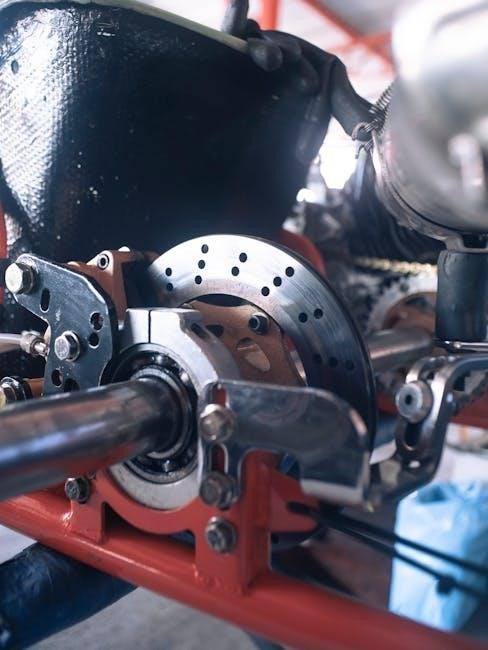Caterpillar bolt torque charts provide essential specifications for tightening bolts to ensure machinery performance, safety, and longevity. They outline precise torque values for various components, preventing damage and ensuring reliability. Proper use of these charts is crucial for maintaining equipment integrity and operational efficiency.
1.1 Overview of Bolt Torque Charts
Bolt torque charts are detailed guides that specify the correct torque values for bolts used in various mechanical applications. These charts are essential for ensuring that bolts are tightened to the precise levels required to maintain structural integrity and prevent failure. They typically include information such as bolt size, material grade, and the recommended torque values in both metric and imperial units. For Caterpillar machinery, these charts are tailored to the specific needs of heavy-duty equipment, ensuring optimal performance and safety. The charts are often provided in PDF formats for easy reference, making them accessible for technicians and mechanics working with Caterpillar equipment. Proper use of these charts is critical to avoid under- or over-tightening, which can lead to equipment damage or operational issues.
1.2 Importance of Torque Specifications for Caterpillar Equipment
Adhering to torque specifications is critical for the proper functioning and longevity of Caterpillar equipment. Incorrect torque application can lead to bolt failure, equipment damage, and safety hazards. Over-tightening may result in stripped threads or component distortion, while under-tightening can cause loose connections and mechanical instability. Torque specifications ensure that all components are securely fastened, maintaining the integrity of the machinery under operational stress. Additionally, following these guidelines helps prevent costly repairs and downtime, ensuring optimal performance and reliability. Caterpillar equipment operates in demanding environments, making precise torque application essential for maintaining safety and efficiency in industrial and construction applications.

Understanding Bolt Torque Specifications
Bolt torque specifications are critical for ensuring proper assembly and preventing damage. They define the precise torque values required for different bolt sizes and materials to maintain reliability and safety.
2.1 What Are Torque Charts?
Torque charts are detailed guides or tables that specify the exact torque values required for tightening bolts in various mechanical applications. They are essential for ensuring bolts are tightened to the correct tension, preventing under-tightening or over-tightening, which can lead to equipment failure or safety hazards. These charts typically list torque specifications for different bolt sizes, grades, and materials, often distinguishing between metric and imperial measurements. By following torque charts, technicians can maintain the integrity and performance of machinery, particularly in heavy-duty applications like Caterpillar equipment. Proper adherence to these specifications ensures reliability, safety, and optimal functionality of the machinery. Torque charts are indispensable tools for any mechanical assembly or maintenance process.
2.2 Key Factors Influencing Torque Values
Torque values are influenced by several critical factors, including bolt size, material grade, thread type, and the specific application. The diameter and length of the bolt, along with its tensile strength, significantly impact the required torque. Material grades, such as steel or alloy, determine the bolt’s strength and elasticity, affecting torque requirements. Thread condition, whether metric or imperial, also plays a role, as thread pitch and depth influence friction during tightening. Additionally, coatings or surface treatments on bolts can alter torque values by changing frictional properties. Environmental factors, like temperature and humidity, may also affect torque specifications. Understanding these factors ensures accurate torque application, preventing under- or over-tightening, which can compromise machinery performance and safety. Always consult official Caterpillar charts for precise specifications tailored to your equipment.
2.3 Differences Between Metric and Imperial Torque Values
Metric and imperial torque values differ in units and measurement standards, crucial for accurate bolt tightening. Metric torque is measured in Newton-meters (Nm), reflecting the international standard, while imperial torque uses pound-feet (lb-ft) or inch-pounds, common in U.S. systems. Conversion between units requires precise calculation to avoid errors. Bolt sizes also vary; metric bolts use millimeters, and imperial bolts use inches, affecting torque specifications. Thread pitch and bolt grades further differentiate the two systems. For example, an M14 bolt might require 124 Nm, whereas a 9/16″ bolt could need 65 lb-ft. Using the wrong system can lead to under- or over-tightening, risking equipment damage. Always refer to Caterpillar’s official charts to ensure correct torque application based on the system in use. Proper adherence prevents mechanical failures and ensures optimal performance. The differences highlight the importance of system compatibility in torque specifications.

Caterpillar Bolt Types and Sizes
Caterpillar machinery uses various bolt sizes, including M12, M14, and M16 metric bolts, and 9/16″ to 3/4″ imperial bolts. Their dimensions and thread pitches are standardized for proper fitment and torque application.
3.1 Common Bolt Sizes Used in Caterpillar Machinery
Caterpillar machinery commonly uses a range of bolt sizes to ensure optimal performance. Metric sizes like M12, M14, and M16 are frequently specified, while imperial sizes such as 9/16″, 5/8″, and 3/4″ are also prevalent. These bolts are chosen for their durability and compatibility with heavy-duty applications. The selection of bolt size is critical to maintain structural integrity and prevent mechanical failure. Proper sizing ensures that torque specifications are met effectively, avoiding under or over-tightening scenarios. Always refer to the official Caterpillar torque chart for precise sizing and torque requirements to guarantee safe and reliable equipment operation.
3.2 Material Grades and Their Impact on Torque Requirements
Material grades significantly influence torque requirements for Caterpillar bolts. High-strength materials like Grade 8 or Grade 9 bolts demand higher torque values compared to lower grades. The tensile strength of the bolt material determines the maximum torque that can be applied without causing damage. For instance, bolts with higher tensile strength require greater torque to achieve the necessary clamping force. Conversely, lower-grade materials may be compromised if over-torqued. The Caterpillar torque chart provides specific guidelines for each material grade, ensuring optimal tightening. Adhering to these specifications is crucial to prevent Bolt failure and maintain machinery performance. Proper material selection and torque application are essential for reliable operation.
3.3 Coatings and Surface Treatments for Bolts
Coatings and surface treatments on Caterpillar bolts play a crucial role in determining torque requirements. Treatments like zinc plating or phosphate coatings reduce friction, affecting the torque needed for proper tightening. Some bolts feature specialized coatings to enhance corrosion resistance, which can also alter torque specifications. The Caterpillar torque chart accounts for these variations, providing specific values for coated and uncoated bolts. Using the correct torque for coated bolts ensures optimal clamping force without damaging the bolt or surrounding material. Ignoring these specifications can lead to under or over-tightening, compromising the integrity of the assembly. Proper consideration of surface treatments is essential for accurate torque application and long-term reliability of machinery components.

Torque Charts for Specific Engine Components
This section provides detailed torque specifications for critical engine components, including cylinder head bolts, main bearing bolts, and connecting rod bolts, ensuring precise tightening for optimal performance.
4.1 Cylinder Head Bolts Torque Specifications
Cylinder head bolts require precise torque values to ensure proper sealing and prevent damage. Torque specifications vary by engine model, bolt size, and material grade. For example, M14 bolts may require 124 Nm (90 lb-ft), while M16 bolts could need 140 Nm (105 lb-ft). It’s critical to follow the manufacturer’s guidelines, as over-tightening can damage threads or stretch bolts, while under-tightening may lead to leaks or reduced engine performance. Always consult the official Caterpillar torque chart for specific engine models to ensure accuracy. Proper torque application is essential for maintaining engine integrity and longevity. Referencing the correct specifications helps prevent costly repairs and ensures optimal operational efficiency.
4.2 Main Bearing Bolts Torque Requirements
Main bearing bolts are critical for engine stability and require precise torque to prevent damage. Torque values vary based on bolt size and material, typically ranging from 190 to 250 Nm. Proper tightening ensures the crankshaft and engine block align correctly, reducing wear and noise. Over-tightening can cause bearing failure, while under-tightening leads to movement and potential engine seizure. Always refer to the specific Caterpillar torque chart for accurate settings, ensuring optimal performance and longevity. Correct torque application is vital for maintaining engine reliability and avoiding costly repairs. Adhering to these specifications ensures the main bearings function as intended, supporting the engine’s rotational forces efficiently.
4.3 Connecting Rod Bolts Torque Values
Connecting rod bolts require precise torque values to ensure proper engine operation and prevent damage. Typical torque specifications range from 140 to 185 Nm, depending on bolt size and material grade. For example, M14 bolts often require 140 Nm, while larger sizes may need up to 250 Nm. Proper tightening ensures the connecting rods are securely fastened, maintaining crankshaft alignment and reducing wear. Over-torquing can stretch or break bolts, while under-torquing may lead to rod bearing failure. Always consult the Caterpillar torque chart for specific values, as variations exist across engine models. Accurate torque application is critical for optimal engine performance and longevity, preventing costly repairs and ensuring reliable operation.

Application and Installation Guidelines
Proper bolt installation ensures machinery reliability and safety. Always reference Caterpillar torque charts for precise values, use calibrated tools, and follow torque sequences to avoid damage or wear.
5.1 Step-by-Step Torque Application Process
Applying torque accurately is critical for ensuring the integrity of Caterpillar machinery. Begin by gathering the correct tools and consulting the torque chart for specific values. Clean and inspect bolt threads to ensure proper engagement. Apply a small amount of lubricant if required by specifications. Tighten bolts in the recommended sequence, starting with lower torque values and gradually increasing to avoid uneven stress. Use a calibrated torque wrench for precision, ensuring readings align with the chart. Double-check each bolt’s torque to confirm compliance. Finally, document the process for future reference and maintenance. This methodical approach ensures optimal performance and prevents potential damage. Proper torque application is non-negotiable for machinery longevity.
5.2 Tools Required for Accurate Torque Measurement
To ensure precise torque measurement, specific tools are essential. A high-quality torque wrench is the primary tool, calibrated to match Caterpillar specifications. An impact wrench may be needed for larger bolts, while extension bars can improve accessibility. A torque multiplier is recommended for high-torque applications. Ancillary tools like thread cleaners and lubricants are also necessary to prepare bolt surfaces. Calibration of tools is critical, with periodic checks by an ISO 9002-certified laboratory. Always refer to the Caterpillar manual for tool recommendations tailored to specific equipment. Using the right tools ensures accurate torque application, preventing under or over-tightening; This adherence to proper tooling supports machinery longevity and operational safety.

5.3 Torque Sequence for Optimal Assembly
A proper torque sequence is critical for optimal assembly and to ensure even distribution of force. Start by identifying the correct bolt pattern from the Caterpillar manual. For engine components, such as cylinder head, main bearing, and connecting rod bolts, follow the manufacturer’s specified sequence. This typically involves tightening bolts in a star or circular pattern to prevent uneven stress. Always apply torque in multiple passes, starting with a lower value and incrementally increasing to the final specification. This method ensures that all bolts are evenly loaded, minimizing the risk of warping or damage to components. Adhering to the recommended sequence is vital for maintaining the integrity of the assembly and ensuring long-term reliability.

Troubleshooting Common Torque-Related Issues
Identify and address torque-related issues promptly to avoid equipment failure. Common problems include bolts slipping, over-torquing damage, and under-torquing consequences. Always adhere to Caterpillar’s torque charts for correction and prevention.
6.1 Bolts Slipping Due to Insufficient Torque
Bolts slipping due to insufficient torque is a common issue that can lead to equipment failure. This occurs when bolts are not tightened to the specified torque values, causing them to loosen over time. Insufficient torque can result from incorrect wrench settings, improper bolt lubrication, or using outdated torque charts. Regular inspections and re-torquing as per Caterpillar’s guidelines can prevent this. Always refer to the official Caterpillar bolt torque chart PDF for accurate specifications. Using a torque wrench and ensuring bolts are tightened in the correct sequence is essential. Addressing slipping bolts promptly avoids further damage to machinery components.
6.2 Damage Caused by Over-Torquing
Over-torquing bolts can lead to severe damage, including stripped threads, bolt fracture, and stretching of bolted components. Exceeding the recommended torque values from Caterpillar’s charts can compromise the structural integrity of machinery, leading to costly repairs. Over-tightening often results from using incorrect wrench settings or ignoring specified torque limits. This can also cause premature wear on bearings and other critical engine parts. Always refer to the Caterpillar bolt torque chart PDF for precise specifications. Using a torque wrench and adhering to the correct sequence can prevent over-torquing. Regular training and adherence to guidelines are essential to avoid such issues, ensuring machinery longevity and operational safety.
6.3 Consequences of Under-Torquing
Under-torquing bolts can lead to loose connections, causing mechanical failures and safety risks. Insufficient torque allows bolts to work loose over time, leading to vibrations, wear, and potential component damage. This can result in fluid leaks, reduced performance, and increased maintenance costs. Under-torqued bolts may also cause misalignment of moving parts, further accelerating wear. Critical components like cylinder heads or bearings are particularly vulnerable. Always refer to the Caterpillar bolt torque chart PDF to ensure proper tightening. Failure to meet torque specifications can void warranties and compromise equipment reliability. Regular inspections are essential to identify and address under-torqued bolts promptly, preventing future issues and ensuring operational safety.

Maintenance and Inspection of Bolts
Regular inspection of bolts ensures tightness and prevents wear. Check torque specs in the Caterpillar bolt torque chart PDF to maintain proper tension and avoid loosening over time.
7.1 Regular Inspection of Bolt Tightness
Regular inspection of bolt tightness is crucial to ensure machinery reliability and safety. Use a torque wrench to verify bolt tension against Caterpillar specifications. Refer to the Caterpillar bolt torque chart PDF for precise values. Inspect bolts in high-stress areas more frequently. Look for signs of loosening, corrosion, or damage. Re-torque bolts as needed to maintain optimal tension. Proper inspection prevents bolt failure and ensures equipment durability. Always follow manufacturer guidelines for inspection intervals and torque settings. Neglecting regular checks can lead to equipment damage or operational risks. Maintain detailed records of inspections for future reference and compliance with maintenance standards.
7.2 Re-Torquing After Initial Installation
Re-torquing after initial installation is essential for maintaining bolt integrity and preventing future issues. Always refer to the Caterpillar bolt torque chart PDF for specific re-torque values. After the initial installation, bolts may loosen slightly due to material settling. Re-torquing ensures optimal tension and prevents potential failure. Use a torque wrench to apply the recommended torque in the specified sequence. Re-torquing is particularly critical for high-stress components like cylinder head bolts and main bearings. Failure to re-torque can lead to equipment downtime and costly repairs. Schedule re-torquing as per the manufacturer’s guidelines, typically after the first few hours of operation. Proper adherence ensures long-term reliability and performance of Caterpillar machinery.
7.3 Storage and Handling of Bolts
Proper storage and handling of bolts are crucial to maintain their quality and performance. Always store bolts in a clean, dry environment to prevent corrosion and damage. Use protective coverings or coatings if storing for extended periods. Handle bolts with care to avoid scratches or bending, as this can compromise their structural integrity. Avoid exposing bolts to extreme temperatures or moisture, which can affect their material properties. When handling, use appropriate tools to prevent over-tightening or stripping of threads. Store bolts in organized compartments based on size and type to ensure easy access and avoid mixing. Regularly inspect stored bolts for signs of rust or damage before use. Follow manufacturer guidelines for storage and handling to ensure bolts remain reliable and perform as intended in Caterpillar equipment.

Resources and References
Official Caterpillar manuals provide detailed torque specifications for bolts, ensuring accurate application. These manuals are available online or through authorized dealers.
Consulting authorized Caterpillar dealers and referring to their official documentation is recommended for precise torque charts and guidelines tailored to specific machinery needs.
8.1 Caterpillar Official Torque Specification Manuals
Caterpillar official torque specification manuals are comprehensive guides providing precise torque values for bolts, nuts, and other fasteners. These manuals are tailored to specific machinery models, ensuring accurate application. They include detailed charts for cylinder head bolts, main bearing bolts, and connecting rod bolts, among others. Available in PDF format, these manuals are easily accessible online or through authorized dealers. They serve as invaluable resources for technicians and mechanics, ensuring compliance with manufacturer standards. Regular updates reflect the latest engineering advancements, making them indispensable for maintaining equipment reliability and performance.
8.2 Online Torque Charts and PDF Guides
Online torque charts and PDF guides are invaluable resources for accessing Caterpillar bolt torque specifications. These documents provide detailed torque values for various bolt sizes, materials, and engine components. Available on Caterpillar’s official website or through authorized dealers, these guides ensure quick reference for technicians. They cover specifications for cylinder head bolts, main bearings, and connecting rods, among others. Regularly updated, these PDF guides reflect the latest engineering standards. Users can download them for offline use, making them convenient for fieldwork. These resources are essential for ensuring accurate torque application, preventing over-torquing or under-torquing, and maintaining equipment reliability.
8.3 Consulting with Authorized Caterpillar Dealers
Consulting with authorized Caterpillar dealers offers personalized support for obtaining accurate torque specifications and bolt torque charts. Dealers provide access to official manuals, ensuring compliance with manufacturer standards. They can assist in interpreting torque charts and offer tailored advice based on specific machinery models. Additionally, dealers often provide updated PDF guides and torque specifications, reflecting the latest technical updates. Their expertise minimizes errors in torque application, enhancing equipment performance and longevity. For complex or specialized torque requirements, dealers are a reliable resource, ensuring that all bolt tightening procedures meet Caterpillar’s rigorous quality standards.
Proper torque application is vital for Caterpillar equipment longevity. Using accurate charts ensures safety, reliability, and optimal performance, adhering to Caterpillar’s high standards for machinery maintenance and operation.

9.1 Summary of Key Takeaways
This guide emphasizes the critical role of Caterpillar bolt torque charts in ensuring proper bolt tightening. These charts provide precise torque values for various bolt sizes and materials, preventing over-tightening or under-tightening. Proper torque application is essential for maintaining equipment integrity, performance, and safety. Understanding the differences between metric and imperial specifications is crucial for accurate torque settings. Regular inspections and adherence to manufacturer guidelines are vital to avoid bolt failure. Consulting official Caterpillar manuals or authorized dealers ensures access to reliable torque specifications. By following these principles, users can optimize the longevity and reliability of their Caterpillar machinery, reducing the risk of mechanical issues and ensuring operational efficiency.
9.2 Final Thoughts on the Importance of Proper Torque Application
Proper torque application is fundamental for ensuring the integrity, performance, and safety of Caterpillar machinery. Using accurate torque specifications from official charts prevents over-tightening, which can damage threads or stretch bolts, and under-tightening, which may lead to loose connections. Consistent torque values ensure reliable mechanical assemblies, minimizing the risk of failure and downtime. Following Caterpillar’s guidelines not only extends equipment lifespan but also enhances operational efficiency. Always refer to official manuals or authorized dealers for precise specifications, as incorrect torque settings can lead to costly repairs. Prioritizing proper torque application is essential for maintaining safety and maximizing the longevity of Caterpillar equipment.

